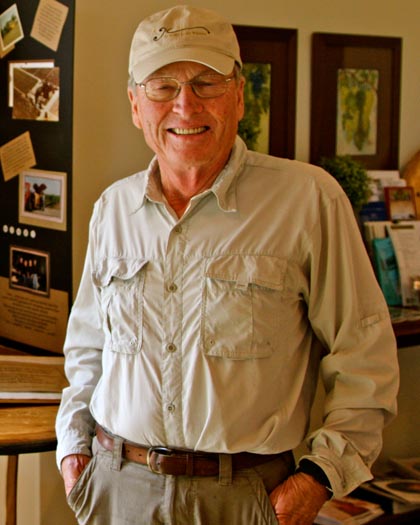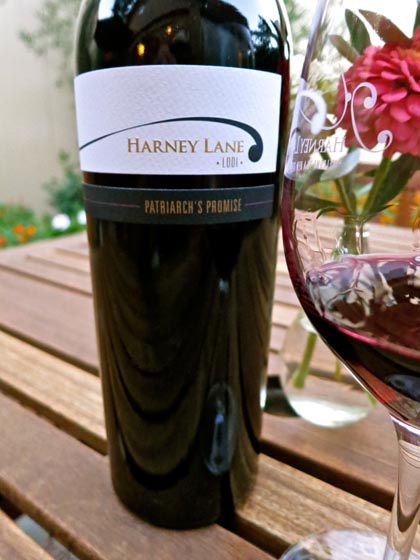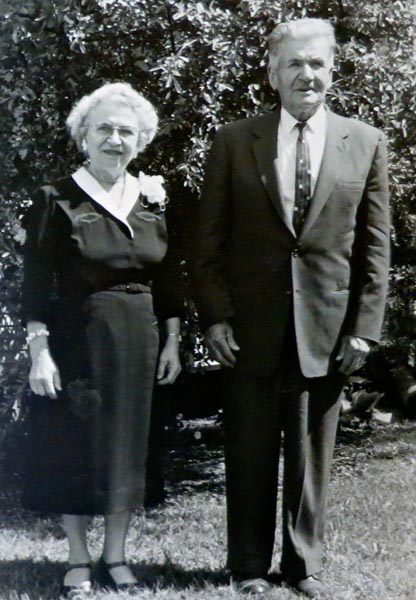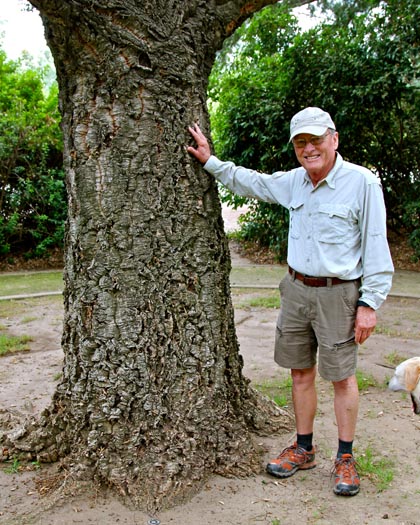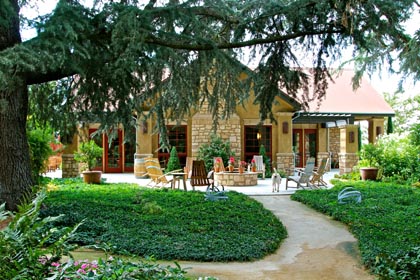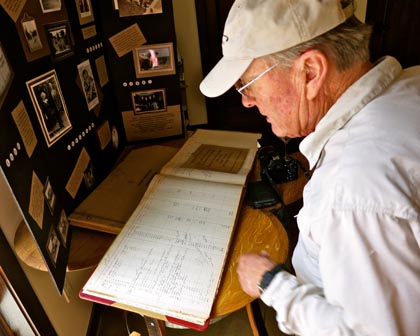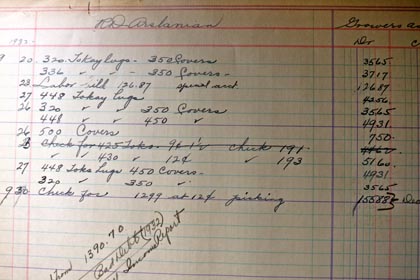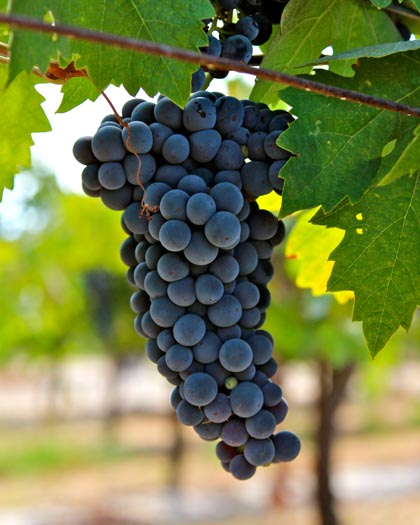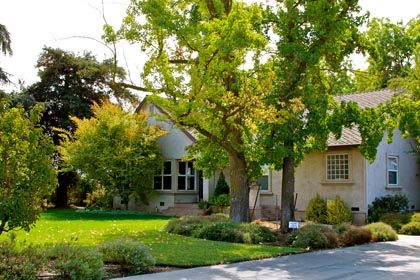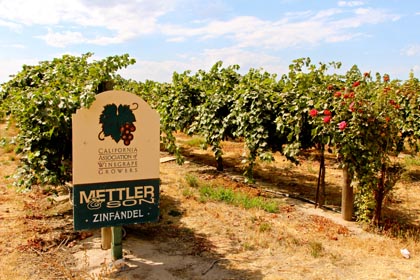Letters from Lodi
An insightful and objective look at viticulture and winemaking from the Lodi
Appellation and the growers and vintners behind these crafts. Told from the
perspective of multi-award winning wine journalist, Randy Caparoso.
Interview with George Mettler: the patriarch of Harney Lane
Harney Lane Wiinery's George Mettler
The latest wine by Harney Lane Winery – a red wine bottled as the Harney Lane Lodi Patriarch’s Promise ($40) – is as special as any that this acclaimed winery has ever made: thick and chewy with dense, yet perfectly smooth, flavors of dried trail-mix berries, spiced with cinnamon, cracked pepper and, strangely enough, aromatic suggestions of fennel root and loamy earth, veering towards a mushroomy broth; at the same time, brightly fruited and full bodied, without tasting weighty or ponderous.
Patriarch’s Promise is also three other things: 1) a non-vintaged blend of some of the winery’s best red wines, culled from consecutive vintages (2007 through 2010); 2) a blend of grapes grown entirely on the property immediately surrounding the Harney Lane Winery; and 3) a liquid essence, and culmination, of the blood, sweat and tears put in by 69 year old George Mettler, the living, breathing patriarchal embodiment of the family that has toiled in the sandy loam soil of Lodi’s Mokelumne River AVA since the turn of the last century.
Harney Lane Winery itself is still, technically, a “new” winery. If it seems like it’s been around a lot longer, that’s because, after being launched in the fall of 2008, success came instantaneously. A double-gold medal in the San Francisco Chronicle Wine Competition (for their 2007 Lizzy James Zinfandel) the following January 2009 confirmed the quality of their work. But it is the legions of fanatical followers, buying up every drop produced almost immediately upon release, that has been the pudding: if you make great wine, they will come.
Does that make Harney Lane an overnight sensation? If you ask Jorja and Kyle Lerner, who co-own and run this winery and vineyard management operation, they’ll tell you it’s not. In Mr. Lerner’s mind, the formula has been as such: “a combination of home, love, laughter, family… and oh, also good grapes.” Without the first four parts, the “good grapes” would not exist, and neither would the award winning wines.
The world, after all, is probably made up of countless families with loving hearts who make perfectly ordinary, if less than stellar, wine. But in Harney Lane’s case – not unlike a number of other successful wineries in the Lodi AVA – the stellar quality of wines produced has very much to do with the work of the family growing the grapes for well over 100 years.
Henry & Elizabeth Schnaidt (1950s)
You cannot, after all, produce extraordinary wine from ordinary grapes. It’s just not possible; especially in the case of Zinfandel vines – which, as everyone knows, tends to produce better and better wines as the years go by (hence, the intrinsic quality of Zinfandels from Harney Lane’s Lizzy James Vineyard, originally planted in 1904).
For Harney Lane, the story goes back to Jorja Lerner’s great great grandfather, Frederick Schnaidt, who originally purchased the property on the east side of Lodi in 1900, after arriving from Menno, South Dakota. Frederick and his son, Henry Schnaidt, planted their first wine grapes in 1906, and it was off to the races.
For decades, Henry and Elizabeth Schnaidt ran farming and grape packing operations; cultivating lots of Zinfandel as well as Tokay, Lodi’s heritage culinary grape. When Henry Schnaidt passed away in 1964, his daughter Frances Mettler and grandson George started up a farm management company, called Mettler & Son; and it was George and (his wife) Kathleen Mettler who finally co-founded Harney Lane Winery, with their daughter Jorja and son-in-law Kyle Lerner.
Last week we got a chance to sit down with George Mettler – looking fresh from a recent fishing trip (his longtime passion) in Alaska, despite an ongoing battle with lung cancer – to hear the story of Harney Lane from his perspective. Our talk took place in the Harney Lane tasting room, as Jorja and her staff were busily getting the place ready for another jam packed weekend of Passport/LoCA Road Trip! crowds.
Our conversation with Mr. Mettler:
The Alaskan air must really do you well, because you’re looking spry this morning.
GM: There is nothing like rainbow trout or silver salmon in an ice cold river, which is a lot of work – fishing can tire you out! Unlike other things, like a trip to Hawaii, where you’re forced to go the opposite and slow down, do nothing, and really get mellow. I have a theory that for every year you live, the year gets 5 days shorter – especially around here at the winery, where things seem to happen fast.
George Mettler & his cork oak
Why don’t you start by telling us how you came by the Mettler name, and how we can distinguish your family from the dozens of other families with the Mettler name, living in Lodi?
GM: The Schnaidt name did not survive in our family because Grandpa Henry and his wife Elizabeth had two daughters, but no sons. It’s a wonder that my hands have five fingers and my feet five toes, because in the old days it wasn’t uncommon to have three marriages within two families, one generation after another. Grandma Schnaidt was a Mettler, and my mother was a Schneidt who married a Mettler – and that was probably just the start of the mix-up.
There seems to be more Mettlers than Schneidts, though, especially here on the east side of Lodi.
GM: Yes, there is. It’s complicated because, like the Mettlers, there were at least two different Schnaidt families who came to Lodi in the 1800s. I think of us as being on the Schnaidt side of the Mettler family. Larry Mettler (who started up Lodi’s nationally distributed Mettler Family Vineyards) is a first cousin – his dad and my dad were brothers. Vic Mettler (who owns and makes the wines of Vicarmont Vineyards) is so distant, I couldn’t begin to tell you where they came from. It’s true that all the Mettlers seem to be concentrated on the east side of Lodi. Once there was a Mettler farming near Jerry Fry (of Mohr-Fry Ranches, located just south of the town of Lodi), but that’s about as far west as any of them got.
Did you grow up right here on the property?
GM: Oh yes, I’m very well traveled. I grew up in the house on the other side of the vineyard, 100 yards from the winery, and now we’re living in the house right next to the winery, where Grandpa Henry lived until the ‘60s.
What was here, where the winery is, before it was built in 2008?
GM: For most of the last century there were a couple of camp houses, where some of our workers lived. Later, in the ‘70s, they were torn down, and up until recently there were a couple of mobile homes in this space.
Harney Lane tasting room
What about the huge evergreen trees between the house and tasting room, making Harney Lane such a beautiful oasis?
GM: Grandpa planted most of these trees, probably in the ‘20s. There is also a big cork oak next to the house, but it was planted in the ‘70s. The cork tree was a gift given to me by Kathleen. I remember seeing a cork tree owned by Larry Mettler, and thinking that it would be a neat thing to have one, too – too bad you can’t get any cork out of it.
But you could, if you wanted, couldn’t you?
GM: I guess you can. We have one because it makes a beautiful tree, not for the cork. When you think of it, it would probably be very special – wouldn’t it? – to have a wine made from grapes grown in our vineyards, bottled with corks from our own tree.
So tell me about the size of the vineyard around the winery, and how the family first got into wine grapes.
GM: There are 64 acres total, 60 acres planted. Grandpa put in the first vines all around the house in 1906 – mostly head trained Zinfandel, with smaller blocks of Tokay and Mission. Through the years the original vines were eventually pulled out and replanted with grapes, or other crops like tomatoes, sugar beets and alfalfa. In the early ‘60s, Grandpa and I planted another block of head trained Zinfandel on the other side of the house, on the west side, and those vines are still there. Originally they were head trained, but afterwards, converted to trellises.
George Mettler looking over old family harvest ledger
Where did the grapes mostly go in the ‘50s, ‘60s and ‘70s?
GM: Mostly to East-Side Winery, the co-op we were members of. Larry Mettler’s family was also real big in East-Side. All the grower cooperatives popped up in Lodi after Prohibition, and we were involved with them until we couldn’t afford to anymore. They started having trouble paying growers in the ‘80s, which is why they’re all gone now. We also used to sell Chenin Blanc to the Guild co-op, and a lot of the grapes went into little boxes that were packed and shipped back east to home winemakers.
To whom did you sell once the co-ops disappeared?
GM: By that time Gallo also moved in. Honestly, though, for what we used to sell to them – it barely covered the cost of picking. You have to give Gallo credit for recognizing the quality of Lodi grapes, just like Robert Mondavi did, but they sure got to be tough customers – always wanting the lowest possible price for the highest possible quality.
Did you sell to Robert Mondavi’s Woodbridge winery as well?
GM: We never did. In fact, I used to wish we could get in on that action. There was a time when folks like Charlie Lewis (longtime eastside Lodi grower) and the Langes (today, of LangeTwins Family Winery & Vineyards) were getting more than $200 a ton more than everyone else around here, selling to Mondavi. But that changed, too, when Woodbridge was sold (in 2004, together with the acquisition of Robert Mondavi Winery by Constellation Brands), and all of the sudden their grape contracts were dropped. That made me glad that we weren’t working with them.
Henry Schnaidt's September 1932 harvest ledger
How important has Zinfandel been for you, all during that time?
GM: Zinfandel always sold pretty well, but we would go through phases. At one point, for instance, we had 20 acres of Chenin Blanc going, in the ‘60s and ‘70s. We’ve done pretty well with Chardonnay, starting in the ‘80s and ‘90s. Of course, table grapes like Tokay were very important, up until the ‘70s. I remembered we tried Petite Sirah one year – we used to call it “peta-sera” – but then it rained and the entire crop turned to rot, and so the next year we grafted it right back to Zinfandel. It seems that we’ve always gone back to relying on Zinfandel. As Grandpa Schnaidt always used to say, “you can never go wrong with Zinfandel.” And now that we’re also a winery, it’s our signature wine.
Harney Lane Zinfandel, Sept. 2012
Did you do well during the White Zinfandel craze?
GM: Believe it or not, the benefits of White Zinfandel lasted only about five years for us. At one point, in ’87-’88, we were selling Zinfandel grapes to White Zinfandel wineries for up to $1,000 a ton. Then the price dropped down quickly, to below $500. It got to the point, in the early ‘90s, when Zinfandel was barely worth picking. I know some Zinfandel people who would pay you to come pick their grapes. By the late ‘90s demand picked up again – of course, it’s been much stronger the last 5 years. The only thing that’s kept it from going through the roof has been the economic crash. Now that wineries have stopped letting their supplies deplete to nearly nothing – after several years of waiting around to see which direction the economy will turn – we’ve been doing great. Of course, now we’re competing with the wineries by making our own wine (note: over 90% of what Mettler & Son farms is still sold to other wineries, with the “cream of the crop” staying with Harney Lane Winery). What we do now is the ultimate way of surviving the ups and downs – the lumps and bumps and the bruises we always used to get – trying to make it just as growers.
Could you talk about the decision to start up Harney Lane Winery?
GM: We started talking about it in 2006, when Kyle and Jorja first presented it. Kyle had been making some wine on the side, and my first response to the idea was that it was a very good one. I was going on 65, starting to slow down and let Kyle and Jorja take over. We we always knew that Lodi could be a successful region for not just growing grapes, but also for wineries. It was just a matter of time for this to happen, the same way that it happened in Napa Valley. It always starts off with just a few wineries, doing very well.
So you are not surprised by the sudden “boom” for Lodi winemaking?
GM: Well, to be honest, we had the idea, but who knew exactly how it would turn out? We did know that something had to give. As Steve Felten (owner/grower of the nationally distributed Klinker Brick Winery, also based in eastside Lodi) says, the only reason he started making wine is because he couldn’t sell the grapes. I don’t think any of us, back in the ‘80s, could envision just how big it would get. Even 10 years ago I don’t think we knew it would grow to over 80 wineries. But now that we’re seeing it, the sky’s the limit.
George Mettler's childhood home in vineyard
Please tell us how the name “Harney Lane” came about.
GM: Jorja says I’m not a normal person because I won’t buy a bottle of wine if it has a gimmicky label – with a picture of Marilyn Monroe, a dog or a squirrel on the label. Chad Joseph (Harney Lane winemaker) originally suggested the name. At the time Chad was making wine at Harmony Wynelands (located just a half-mile from Harney Lane Winery, going east on Harney Lane), where Kyle also had his barrels of homemade wine. Chad’s idea was that our wines should stand for the place where the grapes come from. But believe it or not, he wasn’t the first one to think of that. There was a fellow who grew grapes nearby, by Jack Tone Rd. who once thought of the possibility of starting a winery, and we found out that he already had the name registered, but never got around to starting his winery. Somehow Kyle managed to track him down and, lucky for us, he was happy to sign the name over to us, no charge.
So how are you liking the winery business so far?
GM: Like I said, it sure makes time fly. In November we’re celebrating our third anniversary – or is it already our fourth? If someone told me, 25-30 years ago, that we’d be entertaining all these people and throwing parties all the time here on Harney Lane, I would have said they were crazy. At the same time, I also think – “it’s about time!”
1960s Mettler & Son Zinfandel planting
